Perianal abscesses are disorders that affect the anal area and can cause a great deal of discomfort and agony. These abscesses can cause extreme discomfort, have an influence on one’s day-to-day life, and need to be treated as soon as possible.
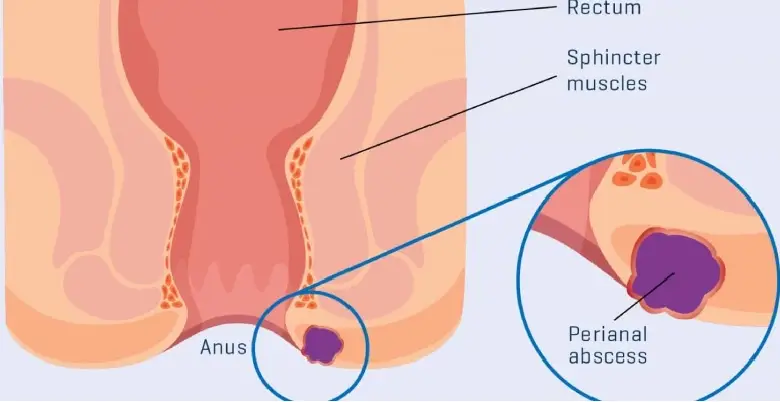
In this extensive blog article, we will look into the many different elements of perianal abscesses, including their symptoms, kinds, diagnosis, treatment choices, complications, prognosis, risk factors, side effects, pre- and post-care, and the related expenses of treatment.
Introduction Perianal Abscess Treatment
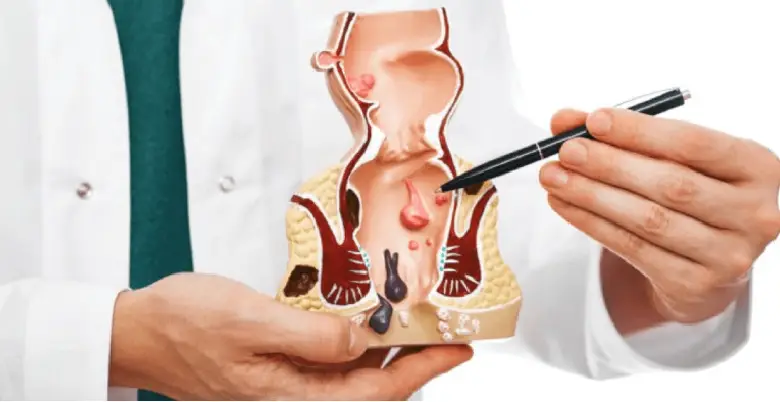
Symptoms
In most cases, perianal abscesses are accompanied by a variety of unpleasant symptoms, which may include the following:
Also read about – Liver cancer
- Pain is the most prevalent symptom, and it can be described as strong and throbbing around the anal region. This discomfort may become more severe while one is seated, when walking, or when one is having bowel motions.
- The perianal area may develop a palpable lump or swelling, which is frequently accompanied by redness and warmth. This symptom may also occur.
- Perianal abscesses can cause a variety of symptoms, including fever, chills, and other indications of infection in certain patients.
- Pus Drainage When the abscess develops, it has the potential to fill with pus, which may eventually drain via an orifice in the skin located close to the anus.
- Drainage: Drainage or discharge that has a foul odour and comes from the anal region is a typical symptom in perianal abscess patients.
Types
Perianal abscesses come in two primary types, each with distinct characteristics and treatment approaches:
Superficial Perianal Abscess
- Location: These abscesses develop close to the anus, usually just beneath the skin.
- Symptoms: Symptoms often include localized pain, swelling, redness, and warmth in the perianal area.
- Treatment: Superficial abscesses are generally less severe and may respond well to less invasive treatments like incision and drainage. Antibiotics are commonly prescribed to prevent infection.
- Prognosis: The prognosis for superficial perianal abscesses is generally better compared to deep abscesses. With appropriate treatment, most individuals can recover without significant complications.
Deep Perianal Abscess
- Location: These abscesses form deeper within the anal canal, often involving multiple layers of tissue.
- Symptoms: Deep perianal abscesses tend to be more painful and severe, with symptoms that can include excruciating pain, fever, and systemic signs of infection.
- Treatment: Due to their depth and severity, deep abscesses often require surgical intervention. Surgical excision, seton placement, or more complex procedures may be necessary. Antibiotics are commonly prescribed post-surgery to prevent infection.
You may also like to read about – Bone Marrow Transplant
- Prognosis: While the prognosis for deep abscesses is generally good with appropriate treatment, there is a higher risk of complications such as fistula formation, which may necessitate additional procedures.
Outlook
Perianal abscesses, if left untreated, can result in major problems, such as the formation of a fistula (an irregular tunnel between the anal gland and the skin) or the transmission of infection to other areas of the body. Because of this, timely diagnosis and treatment are absolutely necessary.
Perianal abscesses can be painful and distressing, but with timely diagnosis and appropriate treatment, most individuals can recover successfully.
Understanding the symptoms, types, diagnosis, treatment options, complications, and costs associated with perianal abscesses is crucial for making informed decisions about your health.
Treatment of Perianal Abscess
Drainage of the abscess, which involves removing the pus and germs that have collected inside the abscess, is the primary therapy for perianal abscesses. The size, depth, and location of the abscess will determine which treatment option is most appropriate.
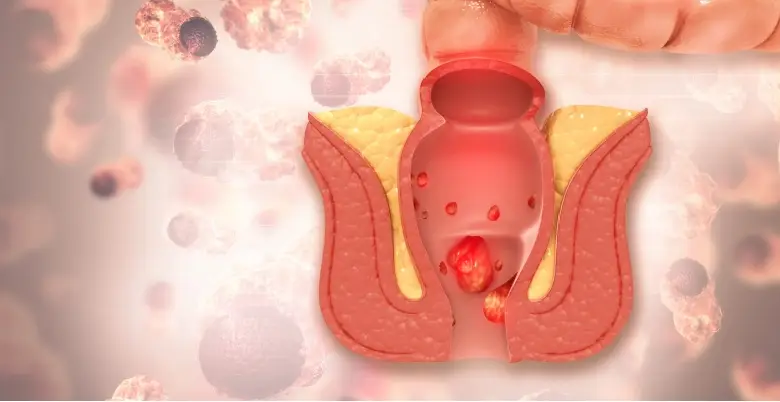
- Incision and Drainage, abbreviated as “I&D,” is a standard approach to the treatment of perianal abscesses. It requires creating an incision in order to create a drainage channel for the pus. After the first drainage, the wound is frequently kept open so that the drainage can continue. Antibiotics are a common course of treatment for preventing infections.
- Surgical Excision: To remove the infected tissue, surgical excision may be necessary in some instances, particularly those with deep perianal abscesses or recurring abscesses. Surgical excision may be required. This treatment is often carried out while the patient is under the influence of anaesthetic.
Read about – Liver Cirrhosis
- In the event that a fistula has formed, additional surgical operations, such as a fistulotomy, may be required in order to treat it. The fistula tract is opened and then drained during a procedure known as a fistulotomy.
- The placement of a seton involves passing a piece of thread or a drain through the fistula tract in order to maintain the fistula tract open and to facilitate drainage. As compared to fistulotomy, this method is considered to be the more conservative option.
Medical and Surgical Options
The treatment of perianal abscesses primarily involves drainage of the abscess to remove the accumulated pus and bacteria. The choice of treatment depends on the abscess’s size, depth, and location.
- Incision and Drainage (I&D): This is a common procedure for treating perianal abscesses. It involves making an incision to allow the pus to drain out. After drainage, the wound is often left open to continue draining. Antibiotics may be prescribed to prevent infection.
- Surgical Excision: In some cases, especially with deep perianal abscesses or recurrent abscesses, surgical excision may be required to remove the infected tissue. This procedure is usually performed under anesthesia.
- Fistulotomy: If a fistula has developed, additional surgical procedures may be necessary to treat it. A fistulotomy involves opening and draining the fistula tract.
- Seton Placement: A seton (a piece of thread or drain) may be placed through the fistula tract to keep it open and promote drainage. This is a more conservative approach when compared to fistulotomy.
Complications
Although the treatment for a perianal abscess is usually successful, there are a few possible risks that you should be aware of.
Development of a Fistula The formation of a fistula is one of the most common consequences, and it can lead to recurring abscesses and chronic pain.
Perianal abscesses have a small risk of recurrence, which means the patient will need extra treatment if it happens.
You should also know – Lip Surgery
Illness May Spread If the infection is not treated as soon as it is discovered, it has the potential to spread to other areas of the body, which can result in more serious health problems.
Prognosis
The majority of perianal abscesses are treatable and can be effectively controlled if given prompt and adequate care. The outlook for superficial abscesses is typically more favourable than it is for deeper abscesses.
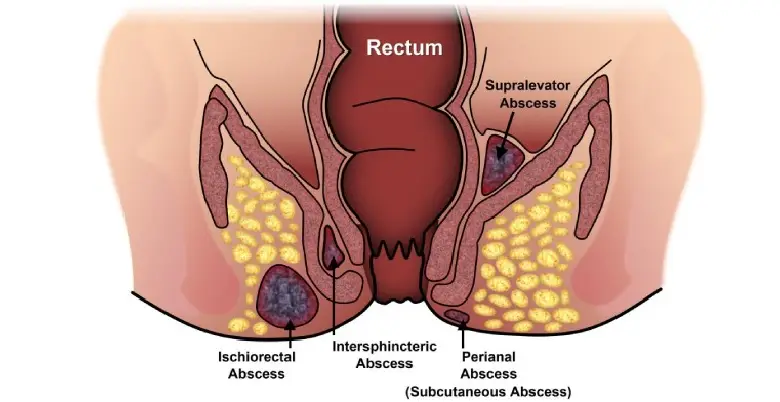
The development of a fistula or recurring abscesses, on the other hand, might make the prognosis more difficult to assess.
Risk Factors
There are a number of risk factors that can contribute to the development of perianal abscesses, including the following: Infection of the Anal Gland An infection of the anal glands is a common precipitating factor in the development of perianal abscesses.
Inflammatory Bowel Disease (IBD): Diseases such as Crohn’s disease and ulcerative colitis raise the likelihood of an abscess developing in the affected area.
Diabetes: Diabetes can impair the immune system, making it easier for infections to occur, especially if the disease is not well treated.
Read More : Human Testis Treatment
Fissures in the anal lining are a potential entrance route for germs. Anal fissures are minute rips in the anal lining.
Adverse Reactions
The strategy that is taken to treat a perianal abscess will determine the adverse effects that are experienced. The following are examples of common adverse effects:
Pain & Discomfort: It is very uncommon for patients to have pain after therapy, particularly after undergoing surgical procedures.
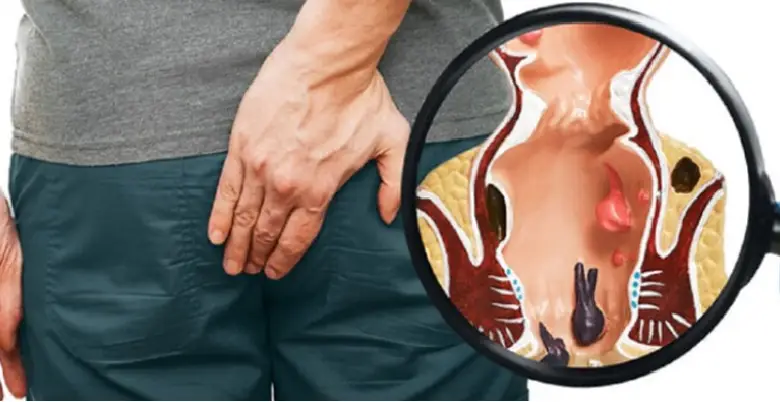
Infection: Although antibiotics are frequently recommended, there is still a danger of infection, particularly if the abscess is not completely drained. This is especially true if the abscess is left untreated for an extended period of time. Scarring is a potential side effect of surgical procedures that are performed in the perianal region.
Before and after care
In many cases, the following steps are necessary to both avoid getting perianal abscesses and ensure a full recovery:
Care Given Before to Treatment
Ensure that you practise proper anal hygiene. Constipation may be avoided by eating foods high in fibre and maintaining a healthy fluid intake. If you observe any of the signs of an abscess, get medical assistance as soon as possible.
Care After Therapy
When it comes to wound care, be sure to follow the recommendations given to you by your healthcare practitioner. Follow the directions for taking any prescription drugs, including antibiotics.
Here is : Angioplasty
Keep all of your follow-up appointments so that your doctor can track how well you are recuperating. Constipation may be avoided by practising healthy bowel habits and avoiding straining, which can make the disease much worse.
Treatment Cost of Perianal Abscess

The cost of perianal abscess treatment can vary widely depending on factors such as:
- Geographic Location: Treatment costs can vary significantly from one region or country to another.
- Healthcare Provider: Costs may differ based on the specific hospital or clinic you choose.
- Treatment Type: Simple incision and drainage procedures are generally less expensive than surgical excision or fistulotomy.
- Insurance Coverage: Health insurance can cover a portion of the treatment costs, so it’s essential to check your policy.
- Additional Services: Any necessary tests, follow-up appointments, or medications can add to the overall cost.
On average, the cost of incision and drainage for a perianal abscess in the United States can range from $1,000 to $2,500, but this can vary widely depending on the abovementioned factors. Surgical procedures and treatments for complications such as fistulas can be significantly more costly.